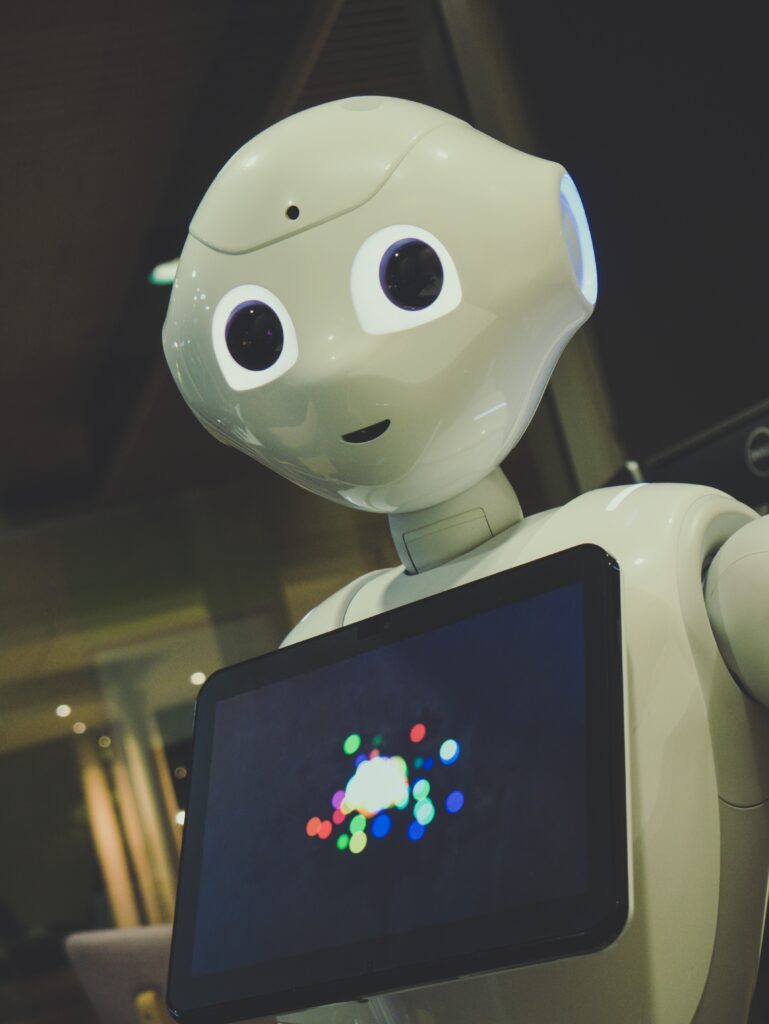Table of Contents
What Is AI? A Beginner’s Guide To Artificial Intelligence

Artificial Intelligence (AI) is a branch of computer science that deals with creating intelligent machines that can perform tasks that usually require human intelligence, such as visual perception, speech recognition, decision-making, and language translation.
AI systems are designed to learn from data, adapt to new inputs, and perform tasks requiring intelligence without being explicitly programmed.
Machine learning is a popular technique used in AI. It involves training models on large datasets to enable them to recognize patterns and make predictions based on new data.
Behind The Scenes Of AI: Understanding How Artificial Intelligence Works

AI systems use algorithms and models to process data and perform tasks requiring human intelligence.
The most common technique used in AI is machine learning, which involves training models on large datasets to enable them to recognize patterns and make predictions based on new data.
There are three main types of machine learning: supervised, unsupervised, and reinforcement.
Supervised learning involves training models on labeled data, meaning the desired output is already known. This type of learning is often used for tasks such as image classification.
On the other hand, unsupervised learning involves training models on unlabeled data, meaning that the desired output is unknown. This type of learning is often used for tasks such as clustering.
Reinforcement learning involves training models through trial and error. The model is rewarded for making correct decisions and penalized for incorrect ones. This type of learning is often used for game playing.
| Supervised Learning | Unsupervised Learning | Reinforcement Learning | |
|---|---|---|---|
| Definition | Learns from labeled data | Learns from unlabeled data | Learns through trial and error |
| Example | Image classification, spam filtering | Clustering, anomaly detection | Game playing, robotics |
| Learning goal | Predict output variable | Discover patterns and relationships | Learn to take actions for reward |
| Training data | Labeled data | Unlabeled data | Noisy or delayed feedback |
| Evaluation | Accuracy, precision, recall | Silhouette coefficient, reconstruction error | Reward signal, Q-value |
| Advantages | High accuracy with labeled data | Discover hidden patterns | Adapt to changing environments |
| Disadvantages | Requires labeled data | No specific goal | Prone to overfitting |
| Applications | Image recognition, speech, NLP | Recommendation, anomaly, data compression | Robotics, game playing, driving |
Another common technique used in AI is deep learning, which involves using neural networks to process data and make predictions.
Deep learning models are designed to learn and extract features from data on their own without the need for explicit feature engineering.
Overall, AI systems use sophisticated algorithms and models to process data and perform tasks usually requiring human intelligence, such as recognizing speech, making decisions, and even learning from data.
Differences Between AI, Machine Learning, And Deep Learning

AI, machine learning, and deep understanding are often used interchangeably but are distinct concepts.
AI is a broad field of computer science that focuses on creating intelligent machines that can perform tasks that usually require human intelligence, such as visual perception, speech recognition, decision-making, and language translation.
Machine learning is a subfield of AI that involves training models on large datasets to enable them to recognize patterns and make predictions based on new data.
Deep learning is a subfield of machine learning that involves using neural networks to process data and make predictions.
| Artificial Intelligence | Machine Learning | Deep Learning | |
|---|---|---|---|
| Definition | Simulates human intelligence | Learns from data | Uses artificial neural networks |
| Function | Makes decisions, recognizes speech and images | Analyzes data, predicts patterns | Performs complex tasks, like image recognition |
| Data | Large amounts of structured and unstructured data | Historical data with labels | Large amounts of labeled data |
| Examples | Robotics, game playing, healthcare | Fraud detection, recommendation systems | Image and speech recognition, self-driving cars |
| Advantages | Wide range of applications, can simulate human intelligence | Can make predictions and identify patterns in data | Can learn from unstructured data and create complex models |
| Disadvantages | Limited to pre-programmed responses, potential for bias | Requires labeled data and ongoing training | Requires large amounts of labeled data, computationally expensive |
| Future | Advancements and applications across industries | Growing importance for data-driven decision-making | Increasing use in complex tasks and industries |
One of the key differences between AI and machine learning is that AI is a broader field that encompasses machine learning and other techniques, such as rule-based systems and evolutionary algorithms.
Machine learning, on the other hand, is specifically focused on training models on data to make predictions or decisions.
Deep learning is a subfield of machine learning that uses neural networks to learn from data.
Unlike traditional machine learning models, deep learning models can independently extract features from data without explicit feature engineering.

This makes them particularly effective for tasks such as image and speech recognition.
In summary, AI is a broad field of computer science focused on creating intelligent machines. In contrast, machine learning is a subfield of AI focused on training models on data.
Deep learning is a subfield of machine learning that uses neural networks to learn and extract features from data.
Why Is Artificial Intelligence Important?

Artificial Intelligence (AI) is crucial because it has the potential to transform many industries and impact our daily lives in significant ways.
One of the key benefits of AI is that it can automate tasks that would typically require human intelligence, freeing people to focus on higher-level tasks that require creativity and critical thinking.
For example, AI-powered robots can perform dangerous or repetitive tasks in manufacturing environments. At the same time, virtual assistants can help us manage our schedules and stay organized.
AI can also help us make more accurate and informed decisions. AI-powered medical diagnosis systems, for example, can help doctors make more accurate and timely diagnoses. In contrast, AI-powered financial systems can help investors make better investment decisions.
Another significant benefit of AI is that it can help us address some of the world’s most pressing challenges.
For example, AI-powered agriculture systems can help farmers optimize crop yields and reduce waste.
In contrast, AI-powered energy systems can help us reduce our carbon footprint and transition to cleaner energy sources.
| Why AI is Important | |
|---|---|
| Efficiency | Automates tasks, reduce errors, and saves time |
| Decision-making | Improves accuracy and speed of decision-making, enables data-driven insights |
| Innovation | Drives innovation and development of new technologies, products, and services |
| Personalization | Enables personalized experiences for customers and users |
| Addressing global challenges | Helps address complex global challenges such as healthcare, climate change, and poverty |
| Economic impact | Contributes to economic growth and competitiveness across industries |
| Competitive advantage | Provides a competitive advantage for businesses that use AI effectively |
| Future-proofing | Prepares individuals and organizations for the future of work and technology |
However, as with any powerful technology, there are concerns about AI’s ethical implications, including bias, privacy, and job displacement.
It’s essential to approach the development and deployment of AI responsibly and ethically to ensure its benefits are maximized and its risks are minimized.
What Are The Advantages And Disadvantages Of Artificial Intelligence?

Artificial Intelligence (AI) has many potential advantages, including automating tasks, making more accurate and informed decisions, and helping us address some of the world’s most pressing challenges. However, there are also potential disadvantages to consider.
Advantages Of AI
- Automates tasks, freeing up time for more complex work
- Makes more accurate and informed decisions based on data analysis
- Improves efficiency and productivity in various industries
- Provides better customer experiences, such as chatbots and personalized recommendations
- Addresses pressing global challenges, such as climate change and disease
- Performs dangerous or repetitive tasks that could be hazardous for humans
- Improves quality of life for people with disabilities
- Creates new job opportunities in AI development and maintenance
- Enhances security measures by detecting potential threats and vulnerabilities
- Revolutionized fields such as education, entertainment, and marketing.
Disadvantages Of AI
- This can lead to job displacement as machines become more capable.
- May be biased or make decisions not in line with human values if trained on subjective data
- Raises concerns about privacy and security due to the collection of personal data
- Requires significant investment in development and maintenance
- Implementing it can be costly and inaccessible to some organizations or individuals.
- This may create ethical dilemmas, such as decisions around life and death in autonomous vehicles or medical systems.
- Requires ongoing monitoring and regulation to mitigate risks and ensure ethical use
- Can have a limited understanding of context and nuances, leading to errors or misinterpretations.
What Are The 4 Types Of Artificial Intelligence?

Artificial Intelligence (AI) is a broad field encompassing several subfields, including machine learning, natural language processing, and computer vision.
However, AI can also be classified into four main types based on its capabilities and functionalities.
- Reactive Machines: Reactive machines are the simplest form of AI that can only react to the current situation based on a pre-programmed set of rules. These machines cannot form memories or use past experiences to inform future decisions. For example, Deep Blue, the computer program that defeated chess champion Garry Kasparov in 1997, is a reactive machine.
- Limited Memory: Limited memory AI systems can use past experiences to inform future decisions. These systems can store and recall past experiences to inform decision-making processes. For example, self-driving cars use limited memory AI to navigate the roads and make decisions based on previous occasions.
- Theory of Mind: Theory of mind AI is a type of AI that can understand and interpret human emotions and behavior. These systems can recognize and respond to human emotions and intentions, making them well-suited for social interactions. However, the theory of mind AI is still in its early stages of development.
- Self-aware: Self-aware AI systems are the most advanced type of AI that can understand their existence and make decisions based on that understanding. Self-aware AI is still purely hypothetical and remains a topic of science fiction.
Overall, these four types of AI represent different levels of capability and functionality. In addition, each type has its own strengths and limitations.
As AI continues to evolve and develop, we can expect to see even more advanced types of AI.
What Are Examples Of AI Technology, And How Is It Used Today?

AI technology has a wide range of applications across various industries. Yet, many of us use it daily without even realizing it.
Here are some examples of AI technology and how they are used today:
- Voice assistants: Voice assistants, such as Siri, Alexa, and Google Assistant, are examples of AI-powered technology that can recognize and interpret human speech. These assistants are used for various tasks, including setting reminders, playing music, and answering questions.
- Recommendation systems: Recommendation systems, such as those used by Amazon and Netflix, use AI algorithms to analyze users’ browsing and viewing history to provide personalized recommendations. This technology is also used in music streaming services, social media platforms, and e-commerce websites.
- Autonomous vehicles: Autonomous vehicles, such as self-driving cars and drones, are powered by AI technology that enables them to navigate the environment and make real-time decisions. These vehicles have the potential to reduce accidents and increase efficiency in transportation.
- Image and speech recognition: AI-powered image and speech recognition technology are used in various industries, including healthcare, finance, and security. For example, image recognition technology is used in medical diagnosis systems to identify potential health issues from medical images. In contrast, speech recognition technology is used in call centers to route calls and improve customer service.
- Fraud detection: AI technology is also used in fraud detection and prevention, particularly in financial industries. AI algorithms can analyze large amounts of data to identify patterns and anomalies indicating fraudulent activity.
Overall, AI technology has many practical applications already in use today. We can expect to see even more advanced AI systems in the future.
As AI technology continues to evolve, it has the potential to transform various industries and improve our daily lives in many ways.
What Are The Applications Of AI?

Artificial Intelligence (AI) has various applications across various industries, and its potential uses constantly expand.
Here are some of the critical applications of AI:
- Healthcare: AI technology improves patient outcomes, reduces costs, and enhances efficiency. AI-powered systems can help doctors make more accurate diagnoses, personalize treatment plans, and identify potential health risks before they become severe.
- Finance: AI is used extensively in the financial industry for fraud detection, risk assessment, and investment analysis. AI-powered systems can analyze vast amounts of data to detect potential threats and identify investment opportunities.
- Transportation: Autonomous vehicles, such as self-driving cars and drones, are powered by AI technology that enables them to navigate the environment and make real-time decisions. AI is also used in traffic management systems to optimize traffic flow and reduce congestion.
- Retail: AI is used to personalize customer experiences, improve inventory management, and optimize pricing strategies. AI-powered recommendation systems can analyze customer data to provide personalized product recommendations and enhance customer satisfaction.
- Manufacturing: AI improves efficiency, reduces waste, and enhances quality control. AI-powered systems can analyze data from sensors and production lines to identify potential issues and optimize production processes.
- Education: AI provides personalized learning experiences, improves student outcomes, and enhances accessibility. AI-powered systems can analyze student data to provide personalized feedback and support and identify improvement areas.
AI technology has numerous practical applications already in use today, and its potential services are constantly expanding.
As AI technology evolves, we expect to see even more innovative applications that can transform various industries and improve our daily lives.
Augmented Intelligence VS. Artificial Intelligence

Augmented Intelligence (AI) and Artificial Intelligence (AI) are related but distinct concepts.
While both involve using technology to improve decision-making, there are some critical differences between the two.
Artificial Intelligence refers to the development of machines and systems that can perform tasks usually requiring human intelligence.
AI systems use algorithms to analyze data, identify patterns, and make decisions based on that analysis.
These systems can automate tasks, make predictions, and learn from experience to improve performance over time.
Augmented Intelligence, on the other hand, refers to using technology to enhance human intelligence and decision-making.
Augmented Intelligence systems are designed to work alongside humans, providing them with information and insights that they can use to make better decisions.
| Augmented Intelligence | Artificial Intelligence | |
|---|---|---|
| Definition | Enhances human intelligence with technology | Simulates human intelligence with technology |
| Function | Enhances human capabilities, improves decision-making | Automates tasks, performs complex tasks without human intervention |
| Interaction | Human and machine work together | Machine works independently |
| Learning | Learns from human input and feedback | Learns from data and algorithms |
| Decision-making | Aids in decision-making process | Makes decisions without human intervention |
| Examples | Virtual assistants, chatbots, analytics tools | Robotics, game playing, speech recognition |
| Advantages | Enhances human intelligence, improves accuracy | Automates tasks, performs tasks faster and more efficiently |
| Disadvantages | Relies on human input and feedback, potential for bias | Potential for errors, lack of human understanding and intuition |
| Future | Growing importance and demand, integration with human workforces | Continued advancements and applications across industries |
These systems can analyze data, identify trends and patterns, and provide recommendations. However, the final decision-making still rests with the human user.
In other words, while Artificial Intelligence seeks to replace human decision-making with automated systems, Augmented Intelligence seeks to enhance and support human decision-making with advanced technology.
One example of Augmented Intelligence is the use of chatbots in customer service.
Chatbots can help answer routine questions and provide essential support, freeing up human agents to focus on more complex issues.
Another example is the use of predictive analytics in healthcare.

Predictive analytics can analyze patient data to identify potential health risks and recommend preventative measures.
However, the final decision-making still rests with the doctor.
Overall, while Augmented Intelligence and Artificial Intelligence involve technology to improve decision-making, they approach the problem from different angles.
Augmented Intelligence seeks to enhance and support human intelligence, while Artificial Intelligence seeks to replace it with automated systems.
Ethical Use Of Artificial Intelligence

As Artificial Intelligence (AI) technology continues to advance and become more prevalent in our daily lives, ensuring that it is used ethically and responsibly is becoming increasingly important.
Here are some critical considerations for the ethical use of AI:
- Transparency: It’s essential to be transparent about how AI systems make decisions and the data they use. This can build users’ trust and ensure that AI systems’ decisions are fair and unbiased.
- Bias: AI systems can be susceptible to bias if trained on partial data or designed with biased assumptions. Identifying and mitigating potential biases in AI systems is essential to ensure they make fair and equitable decisions for everyone.
- Privacy: AI systems can collect and store large amounts of personal data, raising concerns about privacy and data security. It’s crucial to ensure that AI systems are designed with solid privacy and security measures to protect user data.
- Accountability: As AI systems become more autonomous, it’s essential to establish clear lines of responsibility for decisions made by these systems. This helps ensure that AI systems are held accountable for their actions and that appropriate action is taken if something goes wrong.
- Regulation: There is a growing call for constraints around developing and deploying AI systems to ensure they are created and used ethically and responsibly. This can help ensure that AI systems are designed with user safety and well-being in mind and used to benefit society.
Overall, as AI technology continues to advance and become more prevalent in our daily lives, it’s crucial to ensure that it is developed and used ethically and responsibly.
By taking steps to ensure transparency, mitigate bias, protect privacy and security, establish accountability, and regulate the use of AI, we can ensure that these powerful technologies are used to benefit society and improve our lives.
AI Control And Regulations

As Artificial Intelligence (AI) becomes more widespread, there is a growing need for governance and regulation to ensure these technologies are developed and used responsibly and ethically.
Here are some critical considerations for AI governance and regulation:
- Safety: AI systems can cause harm if not developed and used responsibly. Establishing safety standards and protocols is critical to ensure that AI systems are designed with user safety in mind and that appropriate measures are taken to mitigate potential risks.
- Transparency: AI systems can be opaque, making it difficult for users to understand how decisions are being made. Establishing transparency standards is essential to ensure that users clearly understand how AI systems work and how decisions are made.
- Bias: AI systems can be susceptible to bias if trained on partial data or designed with biased assumptions. Establishing guidelines for identifying and mitigating potential biases in AI systems is essential to ensure that they make fair and equitable decisions for everyone.
- Privacy: AI systems can collect and store large amounts of personal data, raising concerns about privacy and data security. Establishing privacy and security standards to protect user data and take appropriate measures to mitigate potential risks is essential.
- Accountability: As AI systems become more autonomous, it cannot be easy to establish accountability for decisions made by these systems. It is essential to establish guidelines for holding AI systems accountable for their actions and ensuring that appropriate action is taken if something goes wrong.
AI governance and regulation are essential to ensure these powerful technologies are developed and used responsibly and ethically.
By establishing safety standards, transparency guidelines, bias mitigation measures, privacy and security standards, and accountability guidelines, we can help to ensure that AI is used to benefit society and improve our lives.
AI tools and services

AI tools and services are a rapidly growing technology with various applications across various industries.
Here are some examples of AI tools and services and how they are being used today:
- Chatbots: Chatbots are AI-powered conversational interfaces that can interact with users in natural language. Chatbots in various industries, including customer service, healthcare, and finance, provide 24/7 support and improve customer experiences.
- Predictive analytics: Predictive analytics is a branch of AI that uses statistical algorithms to analyze historical data and predict future outcomes. Predictive analytics is used in various industries, including healthcare, finance, and marketing, to improve decision-making and identify potential opportunities and risks.
- Natural language processing: Natural language processing (NLP) is a branch of AI that enables machines to understand and interpret human language. NLP is used in various applications, including language translation, sentiment analysis, and chatbots.
- Image and speech recognition: AI-powered image and speech recognition technology are used in multiple industries, including healthcare, finance, and security. For example, image recognition technology is used in medical diagnosis systems to identify potential health issues from medical images. In contrast, speech recognition technology is used in call centers to route calls and improve customer service.
- Autonomous vehicles: Autonomous vehicles, such as self-driving cars and drones, are powered by AI technology that enables them to navigate the environment and make real-time decisions. These vehicles have the potential to reduce accidents and increase efficiency in transportation.
Overall, AI tools and services have numerous practical applications already in use today, and their potential benefits are constantly expanding.
As AI technology continues to evolve, we can expect to see even more advanced AI systems and tools that can transform various industries and improve our daily lives in many ways.
FAQ
What is an AI, in simple words?
AI, or Artificial Intelligence, is a branch of computer science that focuses on developing machines that can perform tasks that generally require human intelligence, such as problem-solving, decision-making, and language translation.
What exactly is AI, and how does it work?
AI technology enables machines to learn from data and make decisions based on that learning. It uses algorithms and statistical models to analyze data, identify patterns, and make predictions or decisions based on that analysis.
What are the 4 types of AI?
The four types of AI are reactive machines, limited memory machines, theory of mind machines, and self-aware machines. Reactive machines are programmed to respond to specific inputs, while limited memory machines can use past experiences to inform decisions. In addition, theory of mind, machines can understand human emotions and beliefs, while self-aware machines can think like humans and understand their existence.
What are AI examples?
Some examples of AI include virtual assistants like Siri and Alexa, chatbots used for customer service, self-driving cars, and facial recognition technology. AI is also used in healthcare, finance, and manufacturing to improve decision-making and automate processes.

